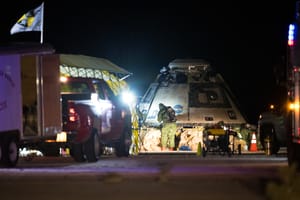
Sep 7, 2024
Starliner returns home alone
After almost three months docked to the International Space Station, Starliner finally began its return to Earth late on Friday the 6th of September, at 22:04 Universal Coordinated Time.
Superb close-up of last night's @Boeing Starliner undock from the Space Station. Zoom in, you can see every bit.
— Chris Hadfield (@Cmdr_Hadfield) September 7, 2024
(video: 4K SpaceTV-1 from the good folks @sen - brand new, freely accessible to the public soon) pic.twitter.com/XPyqk8pK7v
Starliner undocking from the International Space Station, via Cmdr_Hadfield on X.
Approximately five hours after leaving the space station, Starliner performed its deorbit burn at 03:17 am, on September 7th. Shortly after, the capsule of Starliner separated from its service module, leaving its faulty thrusters to burn up in the atmosphere.
After traveling through the fires of atmospheric reentry, both Starliners drogue and main parachutes deployed, followed by jettison of the heat shield, and eventually touching down at the White Sands Space Harbor, in New Mexico.
Speaking after Starliner touched down, Ken Bowersox, Associate Administrator of NASA's Space Operations Mission Directorate, said the following about the Crew Flight Test mission and the future:
“Even though it was necessary to return the spacecraft uncrewed, NASA and Boeing learned an incredible amount about Starliner in the most extreme environment possible. NASA looks forward to our continued work with the Boeing team to proceed toward certification of Starliner for crew rotation missions to the space station.”
As of writing, Starliner is believed to have performed well without any major issues appearing during its return to Earth. Boeing remained confident in Starliner throughout the mission despite concerns from NASA. NASA decided back in August to have Starliner return uncrewed.
What happens to the crew?
The two crew that went up on Starliner back in June, Sunita Williams and Butch Wilmore, are now expected to return on the Crew-9 mission in February 2025. Crew-9 is currently expected to launch in late September with two empty seats.
Returning next February has increased the time Starliner's crew will spend in orbit from just over eight days to eight months. This mission extension is not expected to have any major negative health effects, as several astronauts have spent twelve months in space for one trip.
Until Crew-9 launches, the emergency return spacecraft for the Starliner crew is the Crew-8 Crew Dragon. If an emergency were to occur, the Crew-8 spacecraft would bring six people back to Earth, with Starliner's crew secured beneath the four seats currently installed.
Sunita Williams and Butch Wilmore are both experienced astronauts, with this being the third mission for both. So far, Williams has spent over 410 days in space, with Wilmore having spent over 270 days in space.

Speaking about NASA's decision on August 24th, NASA Administrator Bill Nelson said the following about the agency's reasoning:
“Spaceflight is risky, even at its safest and most routine. A test flight, by nature, is neither safe, nor routine. The decision to keep Butch and Suni aboard the International Space Station and bring Boeing’s Starliner home uncrewed is the result of our commitment to safety"
What's next for Starliner?
Boeing and NASA have not yet announced when another test flight of Starliner will occur. It's also unknown if that next flight will be crewed.
What is known is that Boeing anticipates six more Starliner launches aboard United Launch Alliance's Atlas V. Boeing cannot book any more Atlas V's due to United Launch Alliance having shifted its focus towards its new launch vehicle, Vulcan. As a result, Starliner can only complete a limited number of possible crewed missions before being tested to fly on top of another rocket.
Alongside this, NASA currently doesn't appear ready to fly more than three Starliner missions before the retirement of the International Space Station. This could have Starliner flying once a year, alongside SpaceX's Crew Dragon, between 2026 and 2029, as the space station is set to deorbit around 2030.
What is Starliner?
Starliner is Boeing's crew capsule that operates under NASA's Commercial Crew program, alongside SpaceX's Crew Dragon. The spacecraft can carry four astronauts and 100 kilograms of cargo to the International Space Station, in an emergency it can support seven astronauts. Astronauts inside the capsule of Starliner have access to eleven cubic meters of space.

Starliner consists of a capsule and a service module. The capsule houses the astronauts and the docking system that allows its passengers to enter the International Space Station. The capsule is also designed to be reused up to ten times with a six-month turnaround between missions. Starliner's service module is expended for each mission, it provides power and propulsion to the spacecraft alongside housing the abort system.
The abort system of Starliner uses four Rocketdyne RS-88 engines burning Monomethylhydrazine and Dinitrogen tetroxide to push the spacecraft away from a failing launch vehicle. Fully fuelled atop of a launch vehicle Starliner weighs approximately 13,000 kilograms.



